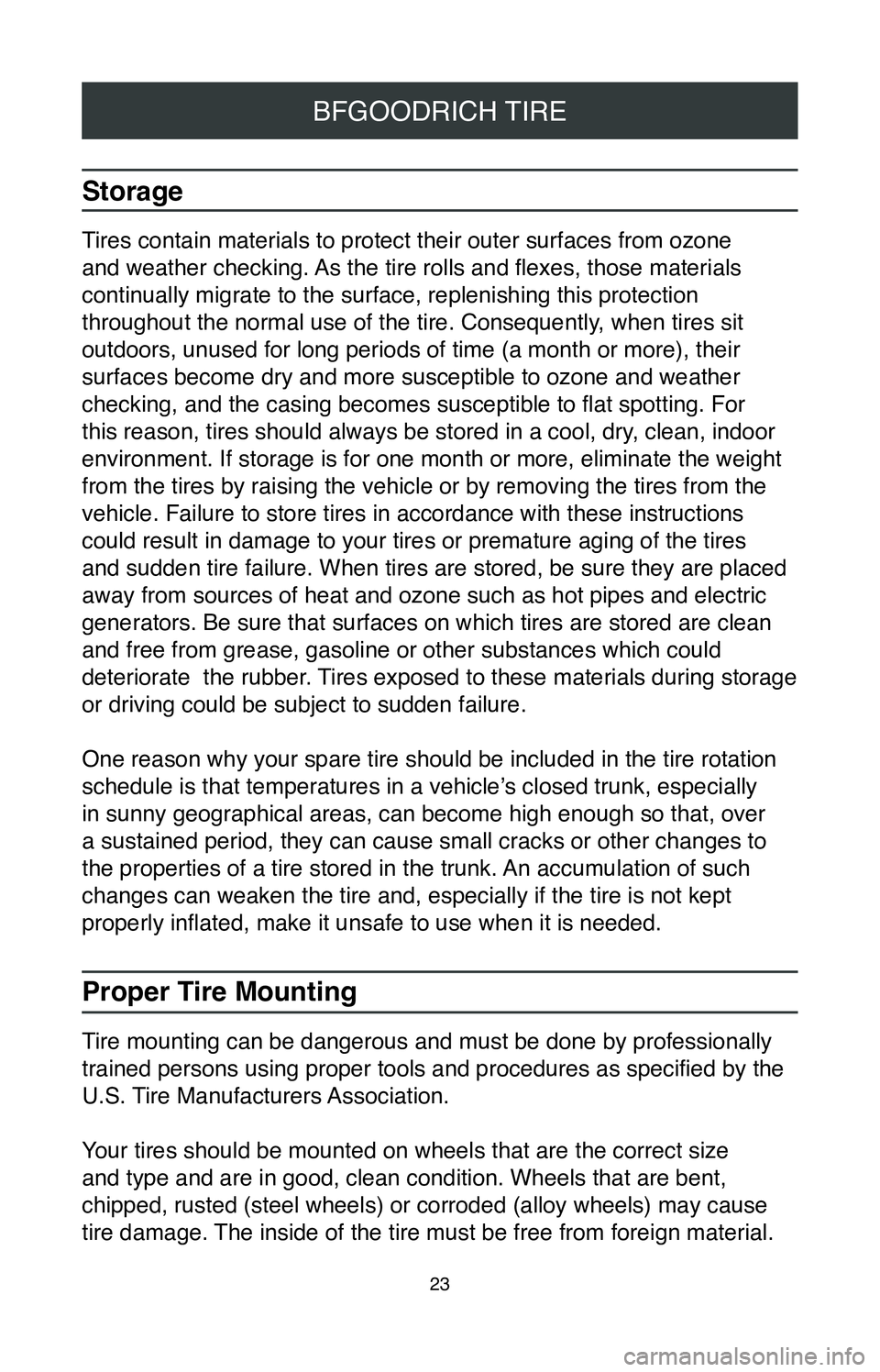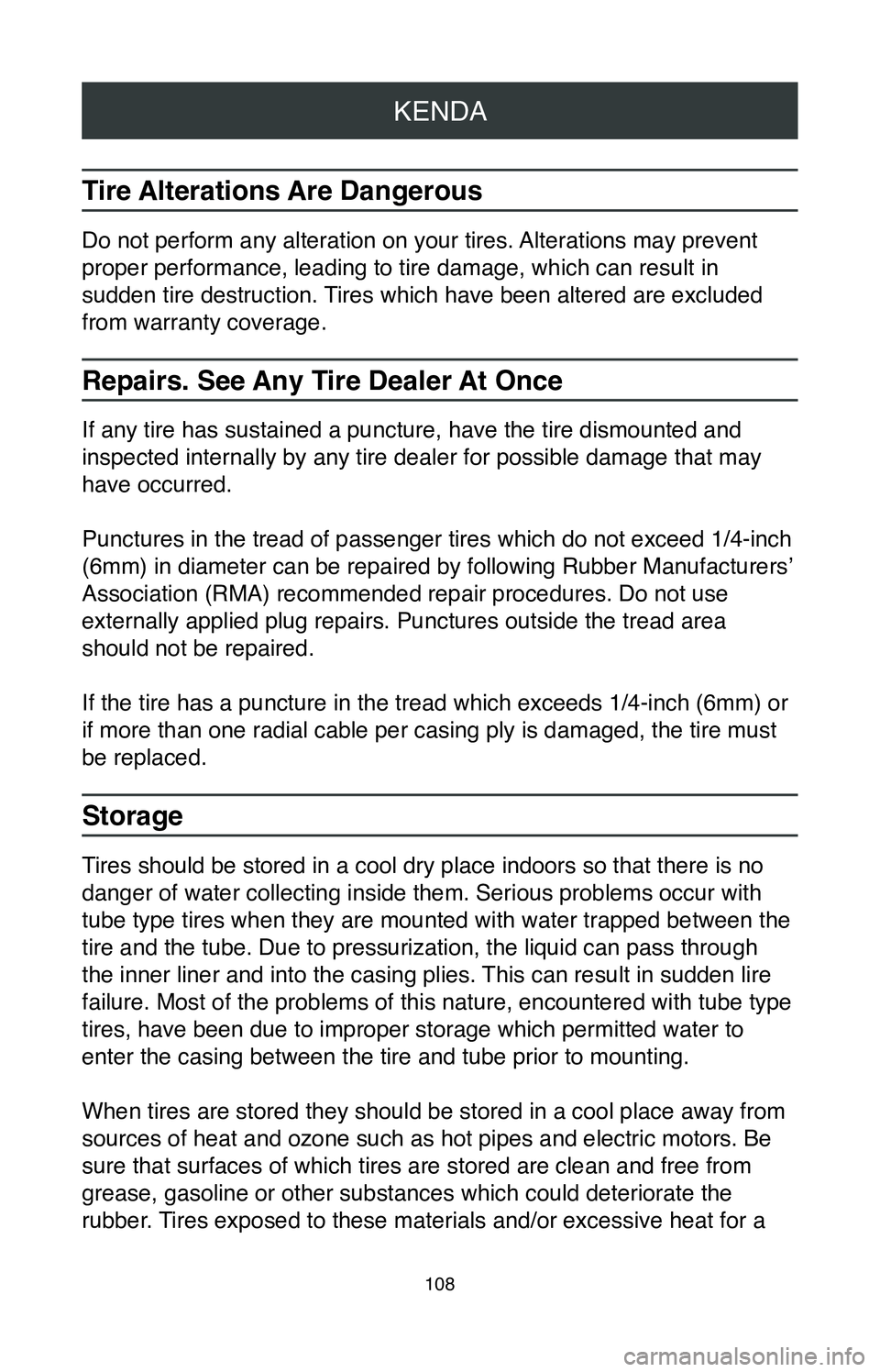gas type TOYOTA C-HR 2020 Warranties & Maintenance Guides (in English)
[x] Cancel search | Manufacturer: TOYOTA, Model Year: 2020, Model line: C-HR, Model: TOYOTA C-HR 2020Pages: 260, PDF Size: 8.54 MB
Page 25 of 260

23
BFGOODRICH TIRE
Storage
Tires contain materials to protect their outer surfaces from ozone
and weather checking. As the tire rolls and flexes, those materials
continually migrate to the surface, replenishing this protection
throughout the normal use of the tire. Consequently, when tires sit
outdoors, unused for long periods of time (a month or more), their
surfaces become dry and more susceptible to ozone and weather
checking, and the casing becomes susceptible to flat spotting. For
this reason, tires should always be stored in a cool, dry, clean, indoor
environment. If storage is for one month or more, eliminate the weight
from the tires by raising the vehicle or by removing the tires from the \
vehicle. Failure to store tires in accordance with these instructions
could result in damage to your tires or premature aging of the tires
and sudden tire failure. When tires are stored, be sure they are placed \
away from sources of heat and ozone such as hot pipes and electric
generators. Be sure that surfaces on which tires are stored are clean
and free from grease, gasoline or other substances which could
deteriorate the rubber. Tires exposed to these materials during storage
or driving could be subject to sudden failure.
One reason why your spare tire should be included in the tire rotation
schedule is that temperatures in a vehicle’s closed trunk, especially
in sunny geographical areas, can become high enough so that, over
a sustained period, they can cause small cracks or other changes to
the properties of a tire stored in the trunk. An accumulation of such
changes can weaken the tire and, especially if the tire is not kept
properly inflated, make it unsafe to use when it is needed.
Proper Tire Mounting
Tire mounting can be dangerous and must be done by professionally
trained persons using proper tools and procedures as specified by the
U.S. Tire Manufacturers Association.
Your tires should be mounted on wheels that are the correct size
and type and are in good, clean condition. Wheels that are bent,
chipped, rusted (steel wheels) or corroded (alloy wheels) may cause
tire damage. The inside of the tire must be free from foreign material.
Page 110 of 260

KENDA
108
Tire Alterations Are Dangerous
Do not perform any alteration on your tires. Alterations may prevent
proper performance, leading to tire damage, which can result in
sudden tire destruction. Tires which have been altered are excluded
from warranty coverage.
Repairs. See Any Tire Dealer At Once
If any tire has sustained a puncture, have the tire dismounted and
inspected internally by any tire dealer for possible damage that may
have occurred.
Punctures in the tread of passenger tires which do not exceed 1/4-inch
(6mm) in diameter can be repaired by following Rubber Manufacturers’
Association (RMA) recommended repair procedures. Do not use
externally applied plug repairs. Punctures outside the tread area
should not be repaired.
If the tire has a puncture in the tread which exceeds 1/4-inch (6mm) or
if more than one radial cable per casing ply is damaged, the tire must
be replaced.
Storage
Tires should be stored in a cool dry place indoors so that there is no
danger of water collecting inside them. Serious problems occur with
tube type tires when they are mounted with water trapped between the
tire and the tube. Due to pressurization, the liquid can pass through
the inner liner and into the casing plies. This can result in sudden lire
failure. Most of the problems of this nature, encountered with tube type\
tires, have been due to improper storage which permitted water to
enter the casing between the tire and tube prior to mounting.
When tires are stored they should be stored in a cool place away from
sources of heat and ozone such as hot pipes and electric motors. Be
sure that surfaces of which tires are stored are clean and free from
grease, gasoline or other substances which could deteriorate the
rubber. Tires exposed to these materials and/or excessive heat for a
Page 142 of 260

MICHELIN
140
from the tires by raising the vehicle or by removing the tires from the \
vehicle. Failure to store tires in accordance with these instructions
could result in damage to your tires or premature aging of the tires
and sudden tire failure. When tires are stored, be sure they are placed \
away from sources of heat and ozone such as hot pipes and electric
generators. Be sure that surfaces on which tires are stored are clean
and free from grease, gasoline or other substances which could
deteriorate the rubber. Tires exposed to these materials during storage
or driving could be subject to sudden failure.
One reason why your spare tire should be included in the tire rotation
schedule is that temperatures in a vehicle’s closed trunk, especially
in sunny geographical areas, can become high enough so that, over
a sustained period, they can cause small cracks or other changes to
the properties of a tire stored in the trunk. An accumulation of such
changes can weaken the tire and, especially if the tire is not kept
properly inflated, make it unsafe to use when it is needed.
Proper Tire Mounting
Tire mounting can be dangerous and must be done by professionally
trained persons using proper tools and procedures as specified by the
US Tire Manufacturers Association (USTMA).
Your tires should be mounted on wheels that are the correct size
and type and are in good, clean condition. Wheels that are bent,
chipped, rusted (steel wheels) or corroded (alloy wheels) may cause
tire damage. The inside of the tire must be free from foreign material.
Have your tire retailer check the wheels before mounting new tires.
Mismatched tires and rims can explode during mounting. Also,
mismatched tires and rims can result in dangerous tire failure on
the road. If a tire is mounted by error on the wrong-sized rim, do not
remount it on the proper rim – scrap it. It may have been damaged
internally (which is not externally visible) by having been dangerously
stretched and could fail on the highway, resulting in an accident.
Old valves may leak. When new tubeless tires are mounted, have
new valves of the correct type installed. Tubeless tires must be
mounted only on wheels designed for tubeless tires, i.e., wheels that